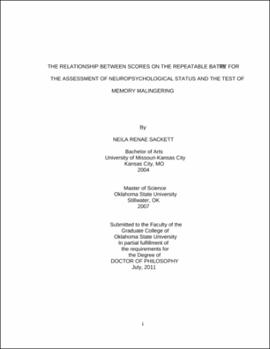| dc.contributor.advisor | Carlozzi, Alfred | |
| dc.contributor.author | Sackett, Neila | |
| dc.date.accessioned | 2013-11-26T08:34:51Z | |
| dc.date.available | 2013-11-26T08:34:51Z | |
| dc.date.issued | 2011-07 | |
| dc.identifier.uri | https://hdl.handle.net/11244/7556 | |
| dc.description.abstract | Scope and Method of Study: The purpose of the current study was to establish a means of assessing and confirming malingering or symptom exaggeration in the context of a brief neuropsychological screening, specifically, the Repeatable Battery for the Assessment of Neuropsychological Status (RBANS). This study used results from the Test of Memory Malingering (TOMM), a well-established measure of malingering on neuropsychological evaluations, to identify subjects suspected of symptom exaggeration. Scores on the TOMM were compared with scores on the RBANS to assess for potential patterns indicative of malingering or symptom exaggeration on the RBANS. Statistical analyses included correlation analysis, multiple regression, and binary logistic regression. | |
| dc.description.abstract | Findings and Conclusions: Correlation analyses revealed that the majority of scores on the RBANS were found to be significantly correlated with effort as determined by the TOMM. Additionally, subtest and index scores on the RBANS were examined to determine their ability to account for variation in TOMM scores. Consistent with the hypothesized relationship, Digit Span and List Recognition subtest scores were found to be predictive of TOMM scores. These two scores, in conjunction with Coding subtest scores, were found to account for 21% of variance in TOMM Scores. The predictive utility of RBANS index scores were examined in a separate regression equation and results indicated that the Attention Index and Delayed Memory Index accounted for 20% of variance in TOMM scores. A third analysis explored the extent to which RBANS subtest and index scores were predictive of group status (i.e., suspected of malingering versus not suspected of malingering.) Two of the RBANS subtest scores, list learning and coding, were found to predict group membership. With regards to index scores, the Attention Index and Delayed Memory Index were found to account for a significant amount of variance in group membership. This study also examined the relationship between the RBANS Effort Index and the TOMM, a well-established measure of malingering on neuropsychological examinations. Results showed scores on the two measures to be significantly correlated. Overall, results from this study supported three of the four hypotheses and established several significant relationships between variables on the RBANS and the TOMM. | |
| dc.format | application/pdf | |
| dc.language | en_US | |
| dc.rights | Copyright is held by the author who has granted the Oklahoma State University Library the non-exclusive right to share this material in its institutional repository. Contact Digital Library Services at lib-dls@okstate.edu or 405-744-9161 for the permission policy on the use, reproduction or distribution of this material. | |
| dc.title | Relationship between scores on the repeatable battery for the assessment of neuropsychological status and the test of memory malingering | |
| dc.contributor.committeeMember | Romans, John | |
| dc.contributor.committeeMember | McGaha, Valerie | |
| dc.contributor.committeeMember | Harrist, Steve | |
| dc.contributor.committeeMember | Payton, Mark E. | |
| osu.filename | Sackett_okstate_0664D_11542.pdf | |
| osu.accesstype | Open Access | |
| dc.type.genre | Dissertation | |
| dc.type.material | Text | |
| thesis.degree.discipline | Counseling Psychology | |
| thesis.degree.grantor | Oklahoma State University | |
